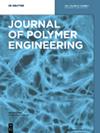禽蛋壳膜衍生的具有潜在骨再生潜力的分散胶原水凝胶的制备
IF 1.7
4区 工程技术
Q4 POLYMER SCIENCE
引用次数: 0
摘要
组织工程作为一种有效的、替代的骨修复策略正在兴起。本研究报道了分散在聚乙烯醇(PVA)中的禽蛋壳膜源性胶原蛋白的潜在和新型骨组织再生基质的开发。水溶性胶原分散体在PVA溶液中的浓度从0.5 %到2 % (w/V)不等;并对溶胶进行不同的冻融循环以达到凝胶化;导致水凝胶基质的制备。通过ATR-FTIR、XRD、FESEM和生物相容性测试对制备的水凝胶的理化性质进行了表征。ATR-FTIR结果显示酰胺A、酰胺I和羟基的存在;XRD研究进一步证实了这一点。通过FESEM对不同水凝胶基团进行形态和拓扑分析。测量结果包括孔隙尺寸(3.98±1.84 µm ~ 9.24±5.55 µm)、孔隙率(47 % ~ 97 %)和平均表面粗糙度(21-39 µm);因此,表明它们是骨组织再生的类似支持系统。此外,在这些支持系统上生长的L929小鼠成纤维细胞表现出良好的细胞活力,从而暗示了其竞争特性和在修复性骨再生方面的应用。本文章由计算机程序翻译,如有差异,请以英文原文为准。
Fabrication of avian eggshell membrane derived dispersed collagen hydrogels for potential bone regeneration
Abstract Tissue engineering is emerging as an effective and alternate strategy for healing the impaired bones. This study reports the development of potential and novel bone tissue regenerating matrices from the avian eggshell membrane derived collagen dispersed in poly-(vinyl alcohol) (PVA). The concentration of the aqueous collagen dispersions within the PVA solution were varied from 0.5 % to 2 % (w/V); and the sols were subjected to varying freeze-thaw cycles to achieve gelation; leading to the fabrication of hydrogel matrices. The developed hydrogels were investigated for their physico-chemical characteristics through the ATR-FTIR, XRD, FESEM and biocompatibility measurements. The ATR-FTIR results showed the presence of amide A, amide I and hydroxyl groups; which were further reinstated by the XRD studies. The morphological and topological analysis of the different hydrogel groups was made through FESEM. It comprised of the measurements of pore dimensions ranging (3.98 ± 1.84 µm to 9.24 ± 5.55 µm), percentage porosity (47 %–97 %), and average surface roughness (21–39 µm); thus, indicating them to be analogous support systems for bone tissue regeneration. Further, L929 mouse fibroblasts grown over these support systems showed excellent cell viability, thus hinting towards its competitive features and application towards remedial bone regeneration.
求助全文
通过发布文献求助,成功后即可免费获取论文全文。
去求助
来源期刊

Journal of Polymer Engineering
工程技术-高分子科学
CiteScore
3.20
自引率
5.00%
发文量
95
审稿时长
2.5 months
期刊介绍:
Journal of Polymer Engineering publishes reviews, original basic and applied research contributions as well as recent technological developments in polymer engineering. Polymer engineering is a strongly interdisciplinary field and papers published by the journal may span areas such as polymer physics, polymer processing and engineering of polymer-based materials and their applications. The editors and the publisher are committed to high quality standards and rapid handling of the peer review and publication processes.
 求助内容:
求助内容: 应助结果提醒方式:
应助结果提醒方式:


